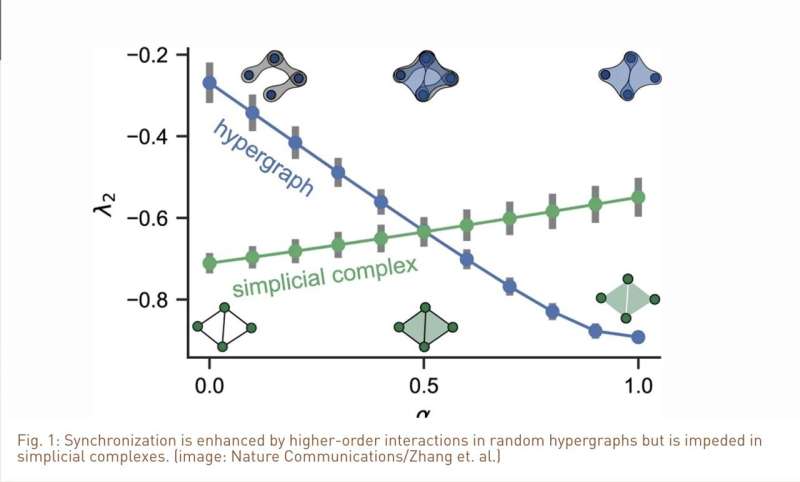This article has been reviewed according to Science X's editorial process and policies. Editors have highlighted the following attributes while ensuring the content's credibility:
fact-checked
peer-reviewed publication
trusted source
proofread
Study: Do higher-order interactions promote synchronization?

Researchers use networks to model the dynamics of coupled systems ranging from food webs to neurological processes. Those models originally focused on pairwise interactions, or behaviors that emerge from interactions between two entities. But in the last few years, network theorists have been asking, what about phenomena that involve three or more? In medicine, antibiotic combinations may fight a bacterial infection differently than they would on their own. In ecology, survival strategies may arise from three competing species that aren't observable when looking at individual pairs.
Network theorists call these phenomena "higher-order interactions." Understanding them can be tricky, says Yuanzhao Zhang, an SFI Complexity Postdoctoral Fellow who uses network theory to study collective behaviors. How the network is represented, for example, can influence how the phenomena emerge.
In a new paper in Nature Communications, Zhang and his colleagues show how the choice of network representation can influence the observed effects. Their work focuses on the phenomenon of synchronization, which emerges in systems from circadian clocks to vascular networks.
Previous studies have suggested that these behaviors can improve synchronization, but the question of when and why that happens has largely remained unexplored.
"We don't have a very good understanding of how the higher-order coupling structure influences synchronization," says Zhang. "For systems with nonpairwise interactions, we want to know, how does their representation affect the dynamics?"
Zhang and his colleagues studied two frameworks used to model interactions beyond pairwise ones: hypergraphs and simplicial complexes. Hypergraphs use so-called "hyperedges" to connect three or more nodes, analogous to how conventional networks use edges. Simplicial complexes are more structured, using triangles (and higher-dimensional surfaces analogous to triangles) to represent those connections. Simplicial complexes are more specialized than general hypergraphs, says Zhang, which means that to model higher-order interactions, triangles can only be added in regions that are already well-connected. "It's this rich-gets-richer effect that makes simplicial complexes more heterogeneous than hypergraphs in general," Zhang says.
Researchers generally don't consider the two frameworks to be very different. "People have been using those two frameworks interchangeably, choosing one or the other based on technical convenience," Zhang says, "but we found that they might be very different" in how they influence synchronization.
In the paper, Zhang and his colleagues reported that networks modeled with hypergraphs easily give rise to synchronization, while simplicial complexes tend to complicate the process due to their highly heterogeneous structure. That suggests choices in higher-order representations can influence the outcome, and Zhang suspects the results can be extended to other dynamical processes such as diffusion or contagion.
"Structural heterogeneity is important not just in synchronization, but is fundamental to most dynamic processes," he says. "Whether we model the system as a hypergraph or simplicial complex can drastically affect our conclusions."
More information: Yuanzhao Zhang et al, Higher-order interactions shape collective dynamics differently in hypergraphs and simplicial complexes, Nature Communications (2023). DOI: 10.1038/s41467-023-37190-9
Journal information: Nature Communications
Provided by Santa Fe Institute





















